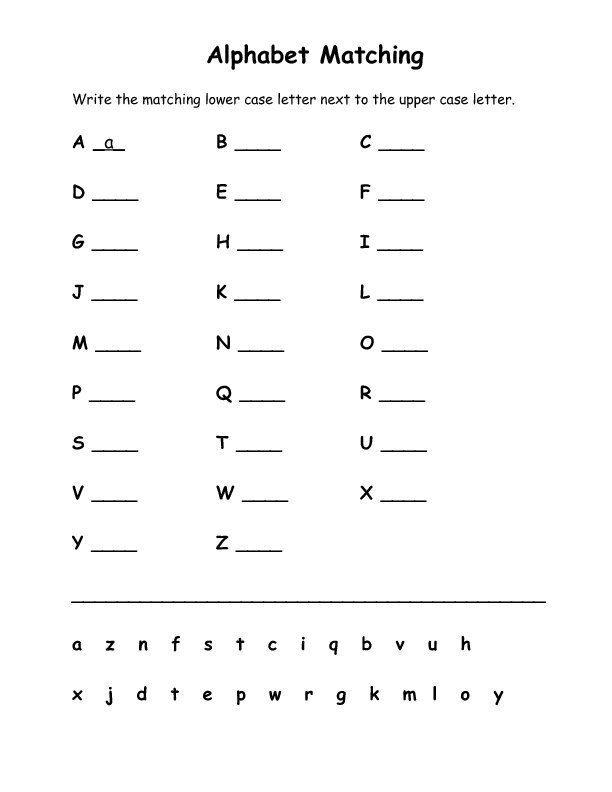TOPIC 1
THE ALPHABET

OBJECTIVES
The purpose of this lesson is to familiarize the students with the alphabet; reciting, identifying, and producing the sound of individual letters.
AGENDA FOR TODAY
1. Warm-up: Sing “The ABC Song”
2. Waking up: Introduce the letters with flashcards.
3. Making association: Do a combination of activities to practice the letters.
4. Gowing up: Review letters with games.
5. Working: Alphabet worksheet.
6. Crowning: Set an alphabet worksheet for homework.
WARM-UP
Starting a class with a warm-up activity promotes interest among the students, it also set a friendly environment, increases our students' participation and attract their attention.
Start this section of the lesson with the ABC song to indicate that it’s alphabet time. If possible, have the letters of the alphabet stuck around the walls of your classroom, high enough so your students can’t take them down, and point at each letter as it is sung. If not, it’s not a problem, sing along with the song and have fun.
WAKING UP
Introduce the alphabet with flashcards, if you don´t have the chance to project the flashcards, you can make it manually.
MAKING ASSOCIATION
Do a combination of activities to practice the alphabet and the phonetic sound.
Below are some activities you can use each time to teach a new letter. Children have a lot of energy so use different activities for each letter to keep things fun and interesting.
• Give and give back: Give the letter flashcard to a student and get him/her to say the letter, sound, and picture before passing back to you. Then do the same with some other students
. • Pass It: Sit with your students in a circle. Hold up a flashcard letter and say the letter (e.g. "A"). Pass it on to the next student who also says it and passes it on to the next student.
• Pick it up: Put the flashcard on the floor and ask individual students to pick it up, say the name, sound and picture and then give back to you.
• Write on the board: kids love writing on the board. After teaching each letter, give a marker to a student and ask him/her to write the letter on the board (as large as they can). You can have more than one student do this for each letter.
GROWING UP
When you have finished teaching the 3-5 new letters you can play a series of games to reinforce these letters, mixed in with the letters your students have learned in previous lessons.
Here are some popular games:
• Find It: Hold up a letter flashcard and the students search around the room for an object beginning with that letter. (e.g. A-arm, B - book, C - clock).
• Vanishing Alphabet Flashcards: place the flashcard letters in front of your students, in the correct order. Tell everyone to close their eyes. Take away one of the flashcards and then tell your students to open their eyes again. The first student to shout out the missing letter can keep that flashcard. At the end of the game, the student with the most letter cards is the winner. Variation: to make it a little more difficult, lay the letter flashcards out in random order.
• Letter touch: Place the alphabet letter cards, face-up, on the floor. Students sit in a circle around the cards. Tell everyone to hold up their hands. The teacher then says a letter and the students must race to touch that letter first. The person who touches the letter first picks up the card and keeps it. At the end of the game, the student with the most letter cards is the winner.
WORKING
Students must write the correct lower case letter to match the upper case letter. Lower case letters are provided in random order for students to choose and copy.

CROWNING
Assign Homework: assign an alphabet worksheet at the end of the lesson to help internalize the new and previously taught letters.

TOPIC 2
Uppercase letter and Lowercase letter

OBJECTIVES
Students will learn to recognize the lowercase and uppercase letters of the alphabet when seeing the letters in print.AGENDA
1. Warm-up: Sing “HELLO HELLO SONG”2. Waking up: Review the alphabet
3. Making association: Write on the boar, use flashcards or project some of the letters of the alphabet in upper and lower cases.
4. Gowing up: Show some examples with upper and lower cases.
5. Working: Activity ( find the lower or upper case for each letter)
6. Crowning: Pause activity.
WARM-UP
This warm-up will help the student to be more active in class.
WAKING UP
Introduce the alphabet with flashcards, if you don´t have the chance to project the flashcards, you can make it manually. Start with lowercase letters and once mastered your students can move on to uppercase letters.
GROWING UP
Hold up two letter-set cards (eg: Ee and Cc) and say, “On each of these cards, we see a capital letter and a small letter. Which one shows a small letter that looks a lot like its capital partner letter?” (Cc). Also, teach them the upper and lower case and the ones that totally different. “Which one shows a small letter that looks quite different from its capital partner letter?” (Ee).

WORKING
Students in small groups will look at the alphabet and find the capital and small letters that look like.
After finish, the first activity, distribute the alphabet (if you have cards if you don't have cards do it manually or write it on the board) and allow students to place them in the appropriate place. When done, hold up each card and ask the class to confirm whether the capital/lower-case letter sets are alike or different. (Alike: Cc, Li, Jj, Kk, Oo, Pp, Ss, Uu, Vv, Ww, Xx, Yy, Zz; Different: Aa, Bb, Dd, Ee, Ff, Gg, Hh, Ll, Mm, Nn, Pp, Qq, Rr, Tt.
CROWNING
Finish the class with an Action song.


No hay comentarios:
Publicar un comentario